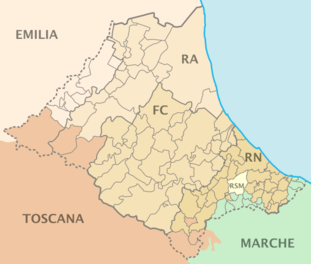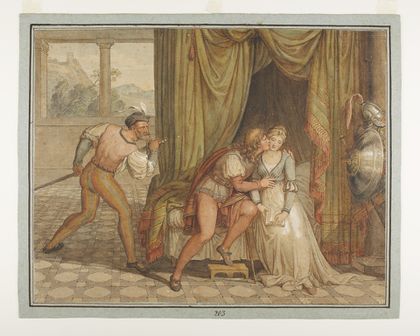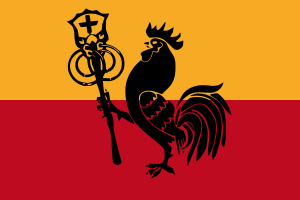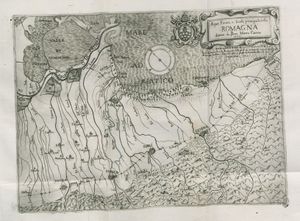رومانيا (إيطاليا)

رومانيا (بالإيطالية: Romagna). منطقة تاريخية وجغرافية ولغوية في شمال إيطاليا، وتطابق تقريبا الجزء الجنوبي الشرقي لإقليم إميليا رومانيا الحالي. Traditionally, it is limited by the Apennines to the south-west, the Adriatic to the east, and the rivers Reno and Sillaro to the north and west. The region's major cities include Cesena, Faenza, Forlì, Imola, Ravenna, Rimini and City of San Marino (San Marino is a landlocked state inside the Romagna historical region). The region has been recently formally expanded with the transfer from the Marche region of nine comuni where the Romagnol language is spoken (Casteldelci, Maiolo, Novafeltria, Pennabilli, San Leo, Sant'Agata Feltria, Talamello, Montecopiolo, Sassofeltrio).[1]
. . . . . . . . . . . . . . . . . . . . . . . . . . . . . . . . . . . . . . . . . . . . . . . . . . . . . . . . . . . . . . . . . . . . . . . . . . . . . . . . . . . . . . . . . . . . . . . . . . . . . . . . . . . . . . . . . . . . . . . . . . . . . . . . . . . . . . . . . . . . . . . . . . . . . . . . . . . . . . . . . . . . . . . .
أصل التسمية
The name Romagna originates from the Latin name Romania, which originally was the generic name for "land inhabited by Romans", and first appeared on Latin documents in the 5th century AD. It later took on the more specific meaning of "territory subjected to Eastern Roman rule", whose citizens called themselves Romans (Romani in Latin; Ῥωμαῖοι, Rhomaîoi in Greek). Thus the term Romania came to be used to refer to the territory administered by the Exarchate of Ravenna in contrast to other parts of Northern Italy under Lombard rule, named Langobardia or Lombardy.
الحدود
حدودها الجغرافية هي : من الغرب نهر سيلارو، وشمالا نهر رينو، ومن الجنوب الغربي تحدها جبال الأبينيني التوسكو-رومانية حتى جبل مادجوي في الألب القمري. ومن هنا تستمر الحدود في خط مستقيم تقريبا على طول الفاصل بين جدول كونكا ونهر فوليا حتى لسان فوكارا البرى داخل البحر، وجنوباً بلدة گابيتشي ماري. ويشكل البحر الأدرياتي الحدود الشرقية.
تشمل منطقة رومانيا : مقاطعة راڤـِنا، مقاطعة فورلي تشيزينا، مقاطعة ريميني، وجزء من مقاطعة بولونيا (إيمولا والمناطق المحيطة بها) وجزء مقاطعة بيزارو وأوربينو (مونتيفلترو)، بالإضافة إلى جمهورية سان مارينو (دولة مستقلة داخل منطقة رومانيا التاريخية). وعموما، تعتبر البلديات التالية أيضا أنها تشكل أجزاء من أراضي رومانيا : بلدة باديا تيدالدا وجزء من بلدية سستينو في مقاطعة أريتسو، وكل من فيورنسوولا وبالاتسوولو سول سينيو ومارادي في مقاطعة فلورنسا.
التاريخ
ما قبل التاريخ
بينت عدد من المواقع الأثرية في المنطقة مثل مونتى پودجولو أن رومانيا كانت ماهولة بالسكان منذ العصر الحجري القديم.
الأومبري والغال
الأومبري الذين تحدثوا لغة منقرضة إيطاليقية هي الأومبرية. وكانوا أقدم قوم وجدت آثارهم في المنطقة. وسكن الإتروسكان أيضا في بعض أجزاء رومانيا.
في القرن الخامس قبل الميلاد، انتقلت عدة قبائل غالية أبرزها اللنگونى والسينوني البوي جنوباً نحو إيطاليا، ونهبت روما في عام 390 ق.م. وقد أخضع السينوني الأومبري تماماً واستقروا في رومانيا. وتوسع السينوني جنوباً نحو أنكونا، مع عاصمتهم Sena Gallica (سنيگاليا). عرف الرومان الأراضي التي سكنها السينونيون سابقا بager Gallicus (السهل الغالي).
ووفقاً للغوي الإيطالي جاكومو دىڤوتو، لا يزال هناك عدد من تأثيرات من اللغة الكلتية في لهجة رومانيولو.
الجمهورية الرومانية
Gallic predominance in the region was consistently challenged by the Romans. In the battle of Telamon in 225 BC, the Romans defeated the joint forces of the Celtic tribes, thus achieving a hegemony over the new Roman Province of Cisalpine Gaul centred at Mutina (modern Modena).
After the Second Punic War, the pro-Carthaginian Lingones and Senoni were expelled. To consolidate the Roman rule in the region, the Via Aemilia was built from Ariminium (Rimini) to Piacentia (Piacenza), and a series of Roman colonies were founded. The most significant ones are Forum Livii (Forlì), Forum Cornelii (Imola) and Forum Popili (Forlimpopoli). After the Social War, the Lex Julia was introduced in 90 BC, and Roman citizenship was granted to all municipia south of the River Po.
In the first Roman civil war, between Gaius Marius and Lucius Cornelius Sulla, most cities in the regions supported Marius. As a result, Forum Livii and Caesena were razed to ground, and the region was looted by Sulla's army.
During the first triumvirate, the Roman Republic was divided along the infamous Rubicon. Most of modern Romagna was ruled by Julius Caesar, with the notable exception of Ariminium, which is south of the river. In 49 BC, Caesar, who had been residing in Ravenna, led the Legio XIII across the Rubicon and ignited Caesar's civil war.
الإمبراطورية الرومانية
After the decisive battle of Actium, the reign of Augustus started a centuries-long era of Pax Romana. All of Cisalpine Gaul had been incorporated into the Roman province of Italia. Around 7 BC, Augustus divided all of Italy into eleven regiones, and most of Romagna (except Rimini) was in the eighth, Aemilia.
Towards the end of the 3rd century, Diocletian re-ordered the Empire into four prefectures, each divided into dioceses, which in turn were divided into provinces. Under the new system, Italy was demoted to a mere Imperial province. Modern Romagna was organized into the Roman province of Flaminia et Picenum in the diocese of Italia Annonaria.
Ravenna, which was surrounded by swamps and marshes, prospered and steadily rose in importance, and a Roman fleet was based at the city. It had developed into a major port on the Adriatic. However, in 330, the capital of the Empire was transferred to Constantinople, so with the fleet that stationed at Ravenna, thus weakened the coastal defence in the Adriatic.
الهجرات الجرمانية وإكسارخية راڤنا
Stepping into the 5th century, the Germanic migrations into the Empire further intensified. In 402, Emperor Honorius even moved the Western Roman Empire's capital from Mediolanum to Ravenna, mainly because of the region's defensive terrain. 8 years later, Alaric I of the Visigoths looted Rome. In 476, Odoacer deposed Romulus in Ravenna, thus marking an end to the Western Empire.
Encouraged by Emperor Zeno, Theodoric the Great led the Ostrogoths into Italy. He entered Ravenna and murdered Odoacer in 493, establishing a twofold kingdom of the Romans and Goths. Under the Ostrogoths Italy was partly restored to its former prosperity.
In 535 Justinian I initiated the Gothic War. It was fought for 20 years, and the Ostrogoths were finally subjugated. The peninsula, depopulated and devastated, was ruled by an exarch from Ravenna. However, Imperial authority was maintained for barely more than a decade. In 568 new Germanic tribes, the Lombards, entered Italy, and established their capital at Pavia. The Empire could barely defend the region around Ravenna and Rome, connected by a narrow strip of land passing through Perugia, as well as a series of coastal cities. The Imperial frontier retreated to Bologna.
In 727 the Lombard King Liutprand renewed war against the Byzantines, taking most of Romagna and besieging Ravenna itself. These territories were returned to the Byzantines in 730. In 737 the king entered Romagna once more and took Ravenna. The exarch, Eutychius, retook the region in 740, with Venetian assistance. Eventually another Lombard king, Aistulf, conquered Romagna once more, and brought an end to the exarchate in 751.
حكم البابوية

. . . . . . . . . . . . . . . . . . . . . . . . . . . . . . . . . . . . . . . . . . . . . . . . . . . . . . . . . . . . . . . . . . . . . . . . . . . . . . . . . . . . . . . . . . . . . . . . . . . . . . . . . . . . . . . . . . . . . . . . . . . . . . . . . . . . . . . . . . . . . . . . . . . . . . . . . . . . . . . . . . . . . . . .
في إيطاليا المعاد توحيدها
However, after joining the unification of Italy in 1860, Romagna was not awarded separate status by the Savoy monarchs, who were afraid of dangerous destabilizing tendencies in the wake of the popular figures cited above.
In the early 20th century the autonomy of Romagna was advocated by Aldo Spallicci, Giuseppe Fuschini, Emilio Lussu and others. A movement proposing separation from Emilia-Romagna was created in the 1990s.
أشخاص بارزون من رومانيا
- Titus Maccius Plautus (c. 254 BC-184 BC), Roman playwright.
- Lamberto Scannabecchi (1060–1130), later Pope Honorius II (1124–1130).
- Melozzo da Forlì (c. 1438–1494), painter.
- Evangelista Torricelli (1608–1647), physicist and mathematician, invented the barometer and contributed to the development of calculus.
- Arcangelo Corelli (1653–1713), baroque violinist and composer.
- Giovanni Battista Morgagni (1682–1771), anatomist, considered the father of modern anatomical pathology.
- Giovanni Vincenzo Antonio Ganganelli (1705–1774), Pope Clemens XIV from 1769, suppressed the Society of Jesus.
- Gioacchino Rossini (1792–1868), musician and composer.
- Giovanni Angelo Braschi (1717–1799), Pope Pius VI from 1775 to his death.
- Barnaba Chiaramonti (1742–1823), Pope Pius VII from 1800 to his death.
- Marco Giuseppe Compagnoni (1754–1833), constitutionalist and writer, father of the Italian flag.
- Felice Orsini (1819–1858), revolutionary, tried to assassinate Napoleon III, Emperor of the French.
- Pellegrino Artusi (1820–1911), writer and businessman.
- Gregorio Ricci Curbastro (1853–1925), mathematician, invented tensor calculus.
- Giovanni Pascoli (1855–1912), poet and scholar.
- Benito Mussolini (1883–1945), politician and journalist, fascist leader of Italy (1922–1943) and the Italian Social Republic (1943–1945).
- Francesco Baracca (1888–1918), WWI flying ace, with 34 confirmed kills against Austro-Hungarian Air Force aircraft.
- Pietro Nenni (1891–1980), politician, secretary of the Italian Socialist Party.
- Federico Fellini (1920–1993), famed film director, writer, and actor, winner of five Academy Awards.
الأعلام المقترحة
Romagna, not being an official administrative subdivision of Italy doesn't have an official flag. Due to the deep cultural identity, many proposals have been advanced, both from political movements or simple citizens looking for a representative symbol.
Lega Nord separatist flag
Lega Nord alternate separatist flag
Autonomist flag proposed by the Movimento per l'Autonomia della Romagna (1991)
المصادر
- ^ "Marche addio: all'Emilia Romagna sette Comuni dell'Alta Valmarecchia". Corriere della Sera (in الإيطالية). Milano: RCS Quotidiani Spa. 29 July 2009. Retrieved 26 May 2018.
وصلات خارجية
- CS1 الإيطالية-language sources (it)
- Pages using gadget WikiMiniAtlas
- Short description is different from Wikidata
- Articles with hatnote templates targeting a nonexistent page
- Articles containing Ancient Greek (to 1453)-language text
- Coordinates on Wikidata
- جغرافية، ومناطق تاريخية وثقافية إيطالية
- جغرافية إميليا رومانيا
- مناطق تاريخية
- تاريخ إميليا رومانيا












